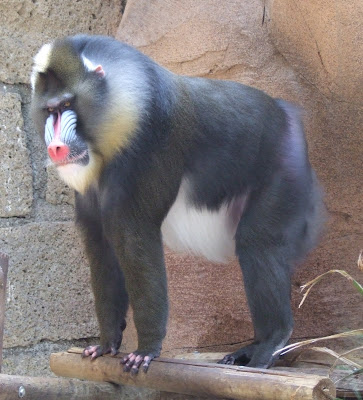My busy virtual mind brought me to the natural world of West Africa, the home of the largest "man-ape". Yes! you are not dreaming! HOME OF THE LARGEST MAN-APE!
Still amazed!?
Now, here's the evidence!
LARGEST MONKEY
HABITAT:
The Mandrill is found in the tropical rainforests and occasionally woodlands of southern Cameroon, Gabon, Equatorial Guinea, and Congo. Its distribution is bounded by the Sanaga River to the north and the Ogooué and Ivindo rivers to the east. Recent research suggests that mandrill populations north and south of the Ogooué river are so genetically different as to be separate subspecies.
BEHAVIOR:
andrills are social animals and live in large groups, primarily including females and young and led by a single dominant male. Most adult males are solitary. It is difficult to accurately estimate group size in the forest, but filming a group crossing a gap between two forest patches or crossing a road is a reliable way of estimating group size. The largest group verifiably observed in this way contained over 1300 individuals, in Lopé National Park, Gabon — the largest aggregation of non-human primates ever recorded.[8]
The Mandrill is an omnivore and acquires its food by foraging (mainly plants, insects and smaller animals) from the ground as it is terrestrial. Although the Mandrill does not normally hunt larger prey, males have been observed to hunt and consume duiker (a small antelope).
Its main natural predators are leopards, pythons and humans. Attacks on subadults by African Crowned Eagles have also been reported. Mandrills are hunted for food throughout their range, either with guns or using dogs and nets. In Cameroon, habitat loss to agriculture is also a threat.
A large group of mandrills can cause significant damage to crops in a very short time, and where common they are widely perceived as pests.
REPRODUCTION:
The gestation (pregnancy) time for the Mandrill is 6–7 months and young are usually born between January and April. However, the mandrill mates throughout the year during the estrous cycle, which occurs once every 33 days. The interbirth interval is typically 13–14 months.
COURTSHIP:
Canadian Researcher William Sommers has found that during courtship, the female will walk after the male. If the male is interested he will stop and turn towards her. He will then mount her and they will copulate.
PARENTING:
Mandrill infants are born with their eyes open and with fur. They have a black coat and pink skin for the first two months. They cling to their mother's belly immediately and can support their own weight. Mothers form bonds with their children. These bonds last into adulthood with the daughters, while the bonds with the sons last only until the males' sexual maturity. These bonds entail the two sitting with each other and grooming each other.
What an amazing mammal!


No comments:
Post a Comment